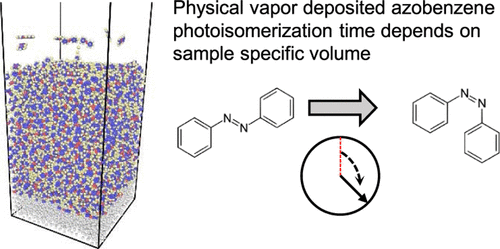当前位置:
X-MOL 学术
›
J. Phys. Chem. B
›
论文详情
Our official English website, www.x-mol.net, welcomes your
feedback! (Note: you will need to create a separate account there.)
Vapor-Deposited Glasses Highlight the Role of Density in Photostability.
The Journal of Physical Chemistry B ( IF 2.8 ) Pub Date : 2020-06-17 , DOI: 10.1021/acs.jpcb.0c03579 K Michael Salerno 1 , Joseph L Lenhart 1 , Juan J de Pablo 2 , Timothy W Sirk 1
The Journal of Physical Chemistry B ( IF 2.8 ) Pub Date : 2020-06-17 , DOI: 10.1021/acs.jpcb.0c03579 K Michael Salerno 1 , Joseph L Lenhart 1 , Juan J de Pablo 2 , Timothy W Sirk 1
Affiliation

|
Photoresponsive molecules can be integrated into glassy materials to probe the local environment and invoke responsive changes in polymer behavior. For example, recent experiments and simulations have studied increased stability in vapor-deposited glasses by examining the photoisomerization rate of a probe molecule. At the theoretical level, past work relied on coarse-grained simulations to explain the role of photoisomerization on glass behavior. In order to effectively exploit these molecular probes, an ability to quantify how the local environment influences the photoisomerization rate is needed. In this work, we present all-atom molecular-dynamics (MD) simulations of molecular glasses of photoresponsive azobenzene (AB) molecules. The stability of these in-silico samples is probed using photoisomerization, where AB molecules can undergo trans → cis transition upon light exposure. Vapor-deposited and bulk-cooled glasses of AB are simulated using a classical dihedral-switching potential developed by Böckmann et al. (J. Phys. Chem. A2010,114, 745–754) to model the photoisomerization process. The MD simulations include thousands of molecules and run for tens of nanoseconds. These size and time scales allow us to explore the broad distribution of photoisomerization wait times, which yields two results. First, the wait-time distributions for both physical vapor deposition and bulk-cooled glasses depend strongly on sample and local density, showing that density or local packing is a primary factor in glass stability against photoisomerization and the experimentally measured photoresponse. Second, the distribution follows a power-law with exponent b ≈ 1.25–1.3 that extends to longer times with increasing density. The power-law distribution suggests a connection with previous experiments that related barriers to photoisomerization with an effective photoisomerization temperature.
中文翻译:

气相沉积玻璃突出了密度在光稳定性中的作用。
可以将光敏分子整合到玻璃材料中,以探测局部环境并在聚合物行为中引起响应性变化。例如,最近的实验和模拟通过检查探针分子的光异构化速率,研究了在气相沉积玻璃中增加的稳定性。从理论上讲,过去的工作依赖于粗粒度模拟来解释光异构化对玻璃行为的影响。为了有效地利用这些分子探针,需要一种量化局部环境如何影响光异构化速率的能力。在这项工作中,我们提出了光响应性偶氮苯(AB)分子的分子玻璃的全原子分子动力学(MD)模拟。使用光致异构化技术探测了这些硅胶样品的稳定性,其中AB分子在曝光后会经历反式→顺式转变。使用由Böckmann等人开发的经典二面体转换势来模拟AB的气相沉积和大体积冷却玻璃。(J.物理 化学 甲2010,114, 745-754),以在光致异构化过程建模。MD模拟包括数千个分子,并且运行数十纳秒。这些大小和时间尺度使我们能够探索光异构化等待时间的广泛分布,这产生了两个结果。首先,物理气相沉积和块状冷却玻璃的等待时间分布在很大程度上取决于样品和局部密度,这表明密度或局部堆积是玻璃抗光异构化和实验测量的光响应的主要因素。其次,分布服从幂律,指数为b≈1.25–1.3随着密度的增加延伸到更长的时间。幂律分布表明与以前的实验有关,后者与有效光异构化温度相关的光异构化障碍相关。
更新日期:2020-07-16
中文翻译:

气相沉积玻璃突出了密度在光稳定性中的作用。
可以将光敏分子整合到玻璃材料中,以探测局部环境并在聚合物行为中引起响应性变化。例如,最近的实验和模拟通过检查探针分子的光异构化速率,研究了在气相沉积玻璃中增加的稳定性。从理论上讲,过去的工作依赖于粗粒度模拟来解释光异构化对玻璃行为的影响。为了有效地利用这些分子探针,需要一种量化局部环境如何影响光异构化速率的能力。在这项工作中,我们提出了光响应性偶氮苯(AB)分子的分子玻璃的全原子分子动力学(MD)模拟。使用光致异构化技术探测了这些硅胶样品的稳定性,其中AB分子在曝光后会经历反式→顺式转变。使用由Böckmann等人开发的经典二面体转换势来模拟AB的气相沉积和大体积冷却玻璃。(J.物理 化学 甲2010,114, 745-754),以在光致异构化过程建模。MD模拟包括数千个分子,并且运行数十纳秒。这些大小和时间尺度使我们能够探索光异构化等待时间的广泛分布,这产生了两个结果。首先,物理气相沉积和块状冷却玻璃的等待时间分布在很大程度上取决于样品和局部密度,这表明密度或局部堆积是玻璃抗光异构化和实验测量的光响应的主要因素。其次,分布服从幂律,指数为b≈1.25–1.3随着密度的增加延伸到更长的时间。幂律分布表明与以前的实验有关,后者与有效光异构化温度相关的光异构化障碍相关。











































 京公网安备 11010802027423号
京公网安备 11010802027423号